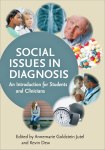Guest post by Annemarie Jutel
Diagnoses are by their very nature well-defined categories. That’s what a diagnosis is: a label for grouping things that are more like X than like Y. It’s influenza, not pneumonia, or it’s rheumatoid arthritis, not multiple sclerosis, and so on. If we didn’t group symptoms and give them diagnostic labels, we would be required to treat each case of sickness as idiosyncratic, or specific to the individual. It would limit the progress we could make in recognizing similarity and looking for treatment. Do we treat this case of aching bones, fever, and headache with this remedy, and that case with that remedy? No, we would like to say that the labels we assign to disease profiles point us towards answers. With a diagnosis, we can assign a treatment, predict a prognosis. But diagnoses aren’t always that clear cut. There are “typical” cases and “atypical” cases of all diseases, but diagnostic tests/diagnosticians are supposed to be able to cut through the fluff to find the medical classification which best fits a given presentation.
One case in point that has received some recent airing in the media is ADHD. While the point of this blog post is not to question the increase of ADHD diagnoses, the relationship between the pharmaceutical industry, and the medicalization of childhood, there is much to be said about this particular diagnosis. One Baltimore doctor noted the high incidence of ADHD diagnosis in her low-income patients and questioned whether these patients were demonstrating trauma reactions, instead of ADHD. Was the patients’ impulsivity the result of a stress response instead of ADHD?
Her concerns about where the line should be drawn and what diagnosis the symptoms are in aid of underlines just how fuzzy the boundaries between different diagnoses, between health and illness, normality and deviance, can be.
“Ah,” you might muse. “That’s always the way with behavioural/psychiatric diagnoses!” And you’d be correct. Psychiatric diagnoses often guard the boundary between normal and abnormal, disease and dysfunction. As my respected colleague Phil Brown once said, psychiatric diagnoses are “low-hanging fruit for the sociologist of diagnosis.”
But these same fuzzy boundaries are present even in the most material of physical diagnoses. What we’d like to think of as the cold, hard reality of disease is often nothing more than our attempt to put boundaries around something that would be easier to manage or confront if it fit into a tidier box. Take a look at my article “When Pigs Could Fly: Influenza and the Elusive Nature of Diagnosis”, which was published in Perspectives in Biology and Medicine. In it, I argue that even very material, physical diagnoses like influenza are far less concrete than their taxonomies suggest. This essay presents influenza as a case study in the elusive nature of the diagnosis and in its complicated realities. Using the metaphor of boundary transgression, I reveal the fluidity of diagnosis and the paradoxes presented by the naturalization of diseases.
Influenza is a “real” virus, yet it changes shape and profile. It’s something we’d all recognise if we “caught” it, yet studies show we’re dreadful at self-diagnosing it. We thought we knew what the typical symptoms of influenza were, but when we ask people to describe their cases, there’s not much in common in their descriptions. We even give it a nickname (flu) that doctors use as often as lay people, as if to suggest we know it intimately. We don’t really.
The presumption that diagnoses are tidy and neat and that they can always explain what ails us is risky business. Diagnoses are technical tools of classification, and play a very helpful role in generalizing. Generalize we must in order to improve both public and individual health. However, remembering that diagnoses have porous boundaries, and that by generalizing similarity we necessarily obfuscate difference, is helpful to understanding challenges to both public and individual.

 Annemarie Goldstein Jutel is an associate professor at Victoria University of Wellington. She is the author of Putting a Name to It: Diagnosis in Contemporary Society and the coeditor of Social Issues in Diagnosis: An Introduction for Students and Clinicians.
Annemarie Goldstein Jutel is an associate professor at Victoria University of Wellington. She is the author of Putting a Name to It: Diagnosis in Contemporary Society and the coeditor of Social Issues in Diagnosis: An Introduction for Students and Clinicians.

